

I can explain how flowering plants reproduce.
Children learn about the pollination of flowering plants by flying insects. They complete a diagram showing the main stages in the insect pollination process.
I can investigate what seeds in a bottle garden need to grow into healthy plants.
Pupils learn what a bottle garden is. They create their own bottle garden, choosing what will go inside and justifying their decisions. Each week, pupils draw their bottle garden and record their observations.

2 pages
I can label the main parts of a plant and explain their function.
Children learn about the four main parts of a plant - leaves, flower, stem and roots. They learn that the roots anchor the plant in the soil and draw up water and nutrients. They learn that the stem supports the plant and allows water and nutrients to travel upward. They learn that the leaves of the plant help the plant to make its own food through photosynthesis. They learn that the flower allows the plant to reproduce through pollination and seed production. Children label a diagram of a plant and describe the functions of its 4 main parts.
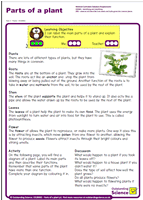
2 pages
I can sequence the different stages in a plant's life.
Children learn about the life cycle of a simple flowering plant - germination, growth, flowering and seed production. They complete and label a diagram of a plant's life cycle and explain the four stages.
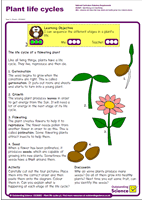
2 pages
I can record how the height of a plant changes over time.
Children plant hyacinth bulbs and help them to grow by giving them soil, water and sunlight. Over a six-week period, children measure the height of the plant, sketch it and describe it.

3 pages
I can investigate what seeds need to germinate.
Children learn about germination. They carry out an investigation into what seeds need to germinate. They set up 6 pots, 5 of which have one ingredient missing. They make predictions, and after 1 week, sketch and describe what has happened.
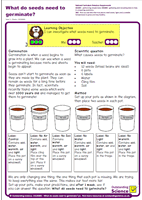
4 pages
I can investigate what bulbs need to start growing again.
Children learn about the function of bulbs. They carry out an investigation into what bulbs need to start growing again.
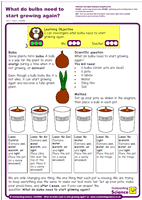
4 pages
I can investigate what plants need to grow well.
Children think about the 3 most important things needed for healthy plant growth. They use this to plan and carry out an investigation.
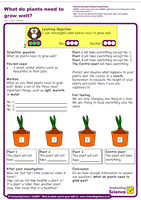
3 pages
I can investigate the needs of different plants.
Children investigate the needs of 4 different plants. They make predictions and observe the plants over a 3-week period.

5 pages
I can investigate what bean plants need to grow well.
Children use what they have learned about plants by having a competition to grow the tallest bean plant. Children consider what type of soil and container to use, where to place their plant, and how often to water it to maximise growth. They measure the height of their plant every week and record their results in a table. At the end of the competition, children complete a pictogram showing the final height of their own plant and 3 others.

4 pages